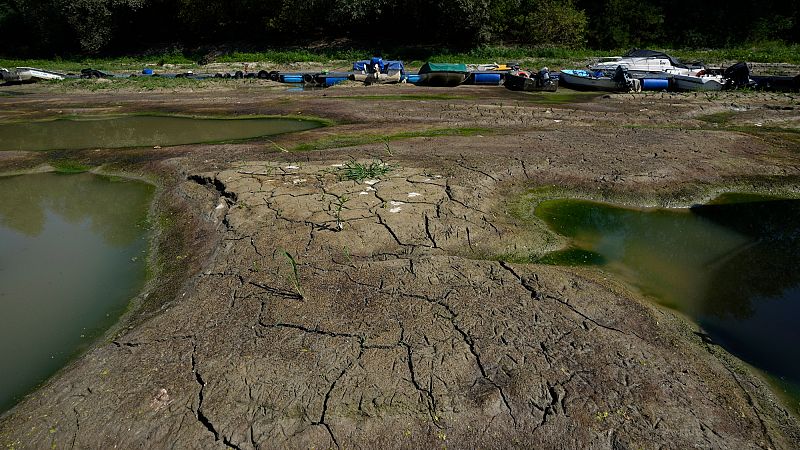
Last year was the warmest year on record both in Europe and globally, with temperatures exceeding all previous levels since 1850. Globally, the last ten years also mark the warmest decade on record.
Europe is the fastest-warming continent on Earth, with the temperature having risen at twice the global average rate since the 1980s, according to the European State of the Climate report.
Several studies show that the growing frequency of heatwaves is already having significant impacts on the European economy, leading to losses in GDP and labour productivity. Experts warn that these economic impacts are set to increase sharply in the coming decades.
The effects of rising temperatures vary significantly across Europe, but Euronews breaks down which countries are facing the biggest losses in GDP and labour productivity.
David García-León and his colleagues, in a study published in Nature Communications, examined heatwaves during four exceptionally hot years — 2003, 2010, 2015, and 2018 — and compared their impacts to the historical baseline of 1981 to 2010.
In those selected years, the total estimated economic damages from heatwaves ranged between 0.3% and 0.5% of Europe's gross domestic product (GDP), covering the EU27, the United Kingdom, and EFTA countries. This represents 1.5 to 2.5 times the average annual economic losses from extreme heat during the 1981–2010 period, which stood at approximately 0.2% of GDP.
These estimates assume no additional mitigation or adaptation measures are implemented.
According to the article, average economic losses from heatwaves are projected to rise from the historical average of 0.21% of GDP (1981–2010) to 0.77% in 2035–2045, 0.96% in 2045–2055, and beyond 1.14% by the 2060s. These predictions might change depending on how much the numbers vary from the average.
The chart above, based on data shared with Euronews by García-León, illustrates the range between the least and most severe projected scenarios.
Southern Europe faces the greatest losses
Countries like Cyprus, Croatia, Portugal, Malta, Spain, and Romania show the highest projected economic losses, with impacts reaching or exceeding -2.5% of GDP by the 2055–2064 period. Greece and Italy (both -2.17%) and France (-1.46%) are also expected to have significant losses by the 2060s.
All these countries are already vulnerable due to their hotter climates and are projected to see the most dramatic increases in heatwave damage.
UK and Ireland least affected
UK, Ireland, Denmark, the Netherlands and Belgium show relatively lower GDP impacts, generally staying below -0.5% even in the worst-case future scenarios. However, almost all countries, even in cooler regions, show a consistent downward trend, indicating worsening effects over time.
OECD reveals potential labour productivity losses
The 2024 OECD report by Hélia Costa and her colleagues, covering 23 countries — including 21 in Europe, along with Japan and South Korea — finds that high temperatures reduce labour productivity. The research draws on detailed weather data and financial information from over 2.7 million firms between 2000 and 2021.
They find that both an increase in the number of high-temperature days and the occurrence of heatwaves substantially reduce labour productivity. Their baseline estimates show ten extra days above a temperature of 35°C during a year result in a 0.3% reduction in firms’ annual labour productivity. This is 0.2% when measured above 30°C.
When it is above 40°C, the impact grows sharply — cutting productivity by over 1.5%, reaching 1.9%. The effects range from -1.1% to -2.7%, suggesting that in this most extreme scenario, losses can exceed 2.5%.
Spain hit hardest by heat stress
OECD’s simulations also revealed the potential productivity losses due to heat stress across countries in the sample period and the future. Spain recorded the highest change in labour productivity due to the rise in heat stress days, with a decline of 0.22% between the periods 2000–2004 and 2017–2021.
France and Hungary followed, each with a 0.13% loss. Other countries with losses of 0.1% or more include Slovakia, Bulgaria, Slovenia, Italy, Poland, and Romania.
When heat stress is associated to a 2°C temperature increase in the simulation, representing future conditions, the level of productivity losses rises sharply. The simulation suggests that labour productivity could fall by over 0.8% in Spain, and by around 0.5% in Italy and Bulgaria. In contrast, northern countries like Denmark and Finland are expected to face the smallest losses.
Among Europe’s five largest economies, the UK consistently shows the lowest decline in productivity across both scenarios.
Are European countries paying attention?
David García-León, science adviser at the Spanish Ministry of Agriculture, Fisheries and Food, noted that some adaptation practices are already common in Europe. For example, outdoor workers often shift their working hours during the summer months and take mandatory breaks to avoid heat stress.
“These practices will inevitably need to expand to more northern regions as heatwaves become more frequent and intense,” he told Euronews Business.
He said that some countries have already implemented tools like localised early warning systems for extreme heat, but these need to be expanded across Europe.
Hélia Costa, economist at the OECD, pointed out that many have implemented or proposed measures like regulating outdoor work during heatwaves.
Policy recommendations from experts
Costa offered two critical policy priorities.
“First, the urgent need to maintain and scale up robust climate mitigation efforts to curb the rising intensity and frequency of heatwaves – and thereby reduce the damage at the source,” she told Euronews Business.
“Second, we stress the importance of adopting adaptation measures, like improving workplace ventilation, adjusting working hours to avoid peak heat, or expanding urban green spaces to lower ambient temperatures,” she added.
García-León emphasised that previous measures are no longer sufficient, given the increasing frequency and intensity of extreme heat events.
“Occupational health policies must be complemented by broader public policies that support the design of local adaptation plans. For example, urban and spatial planning measures are essential to mitigate the heat island effect,” he said.
The European countries most affected by climate change vary significantly.







